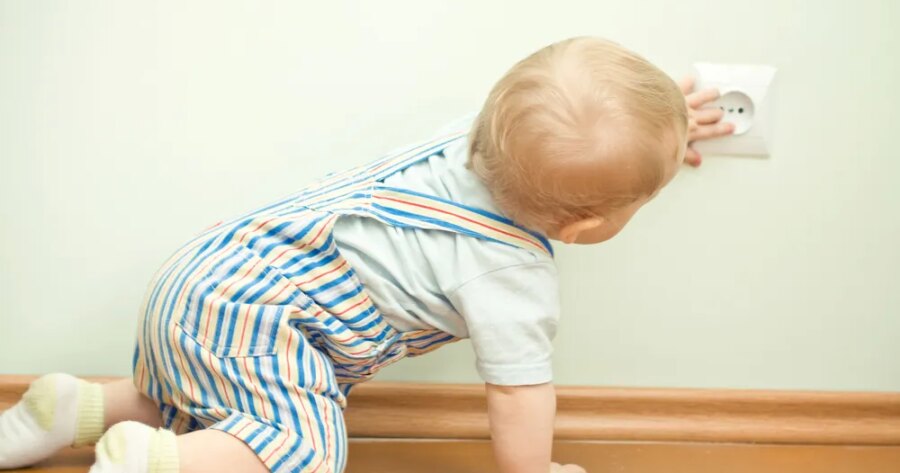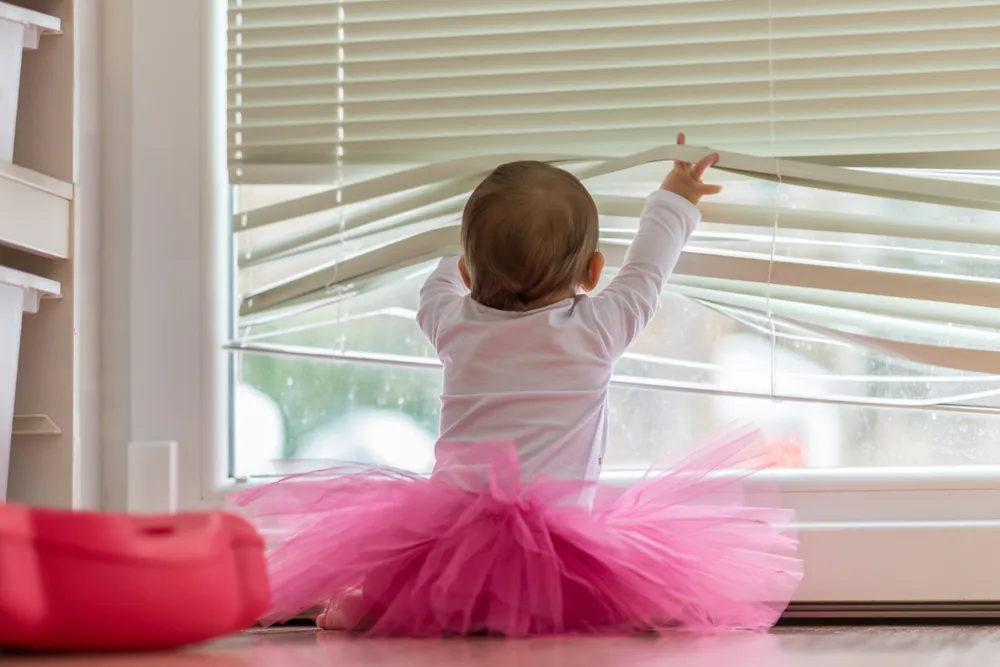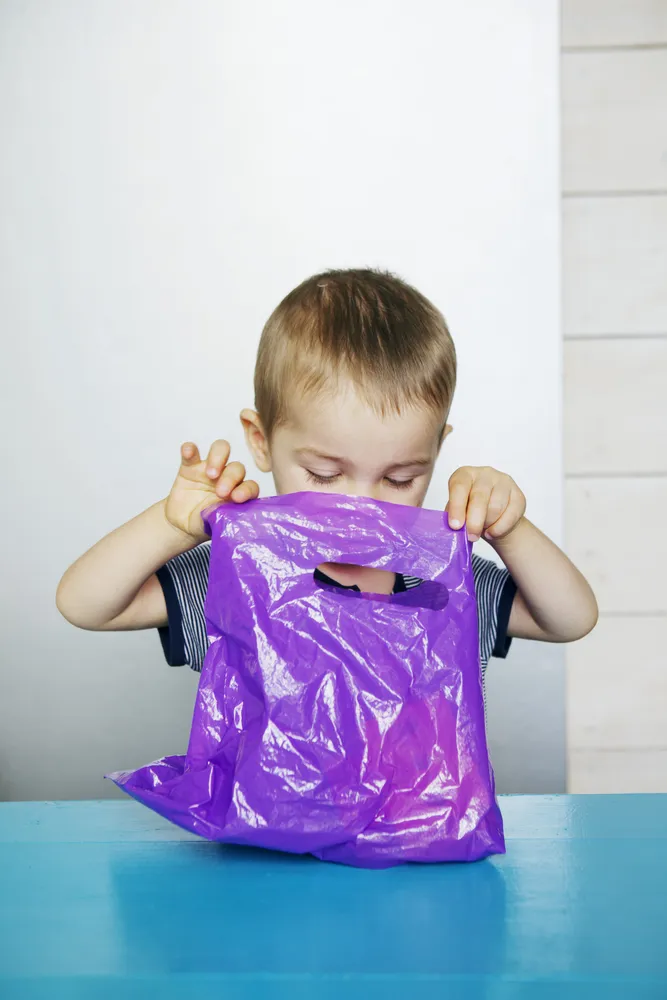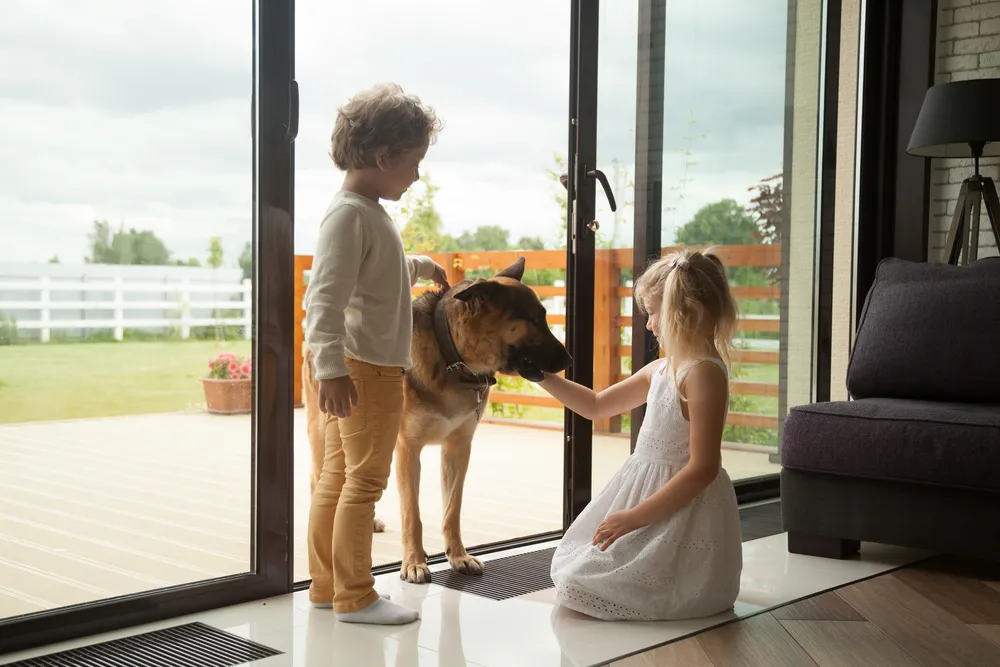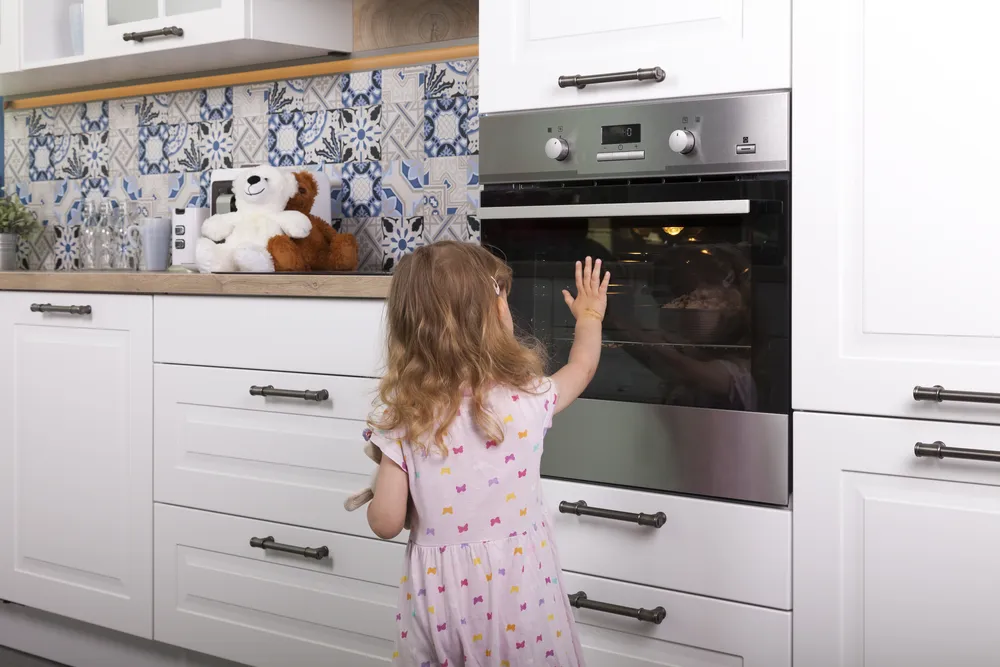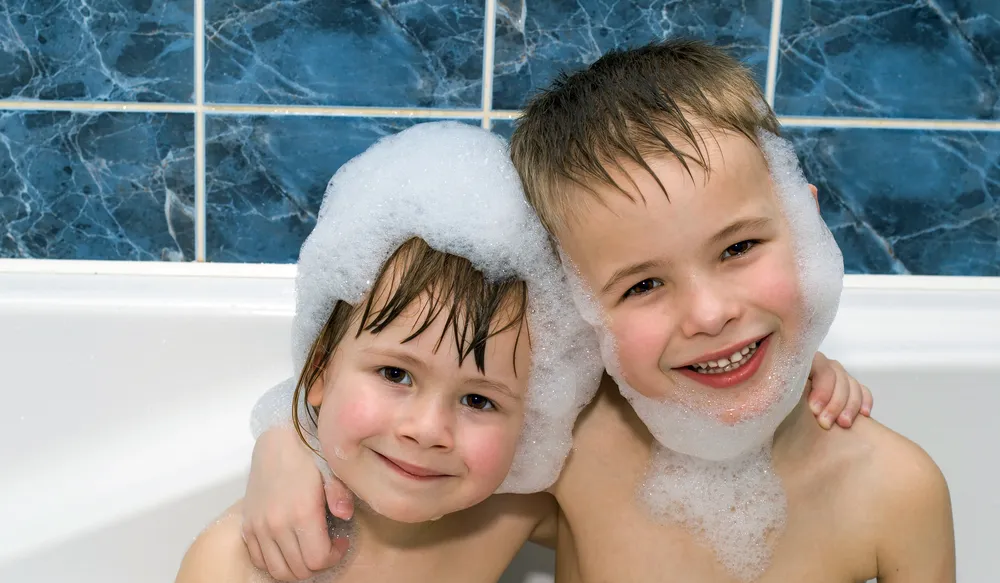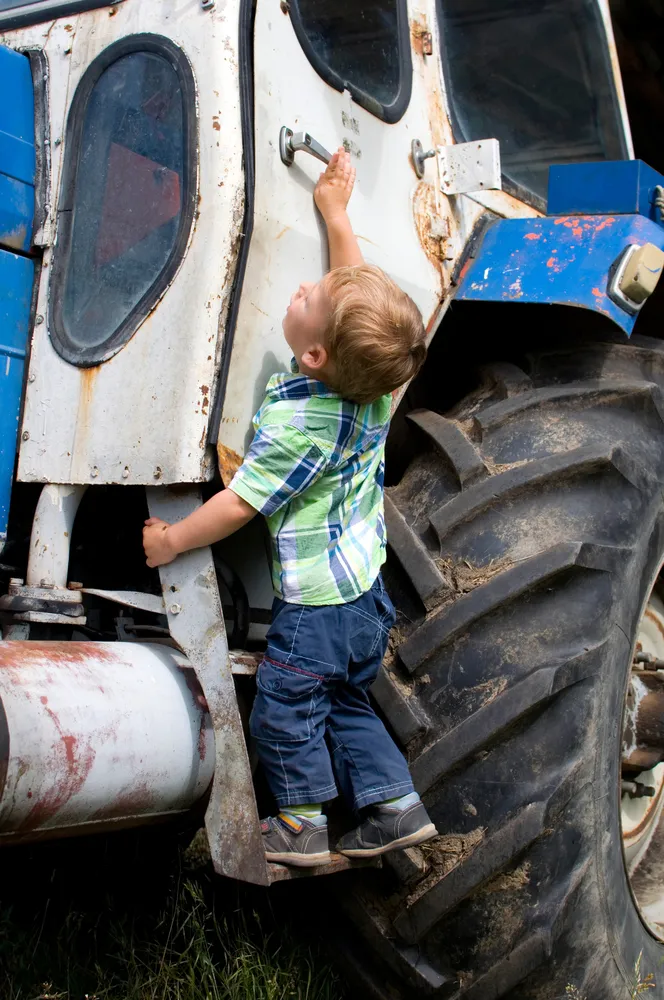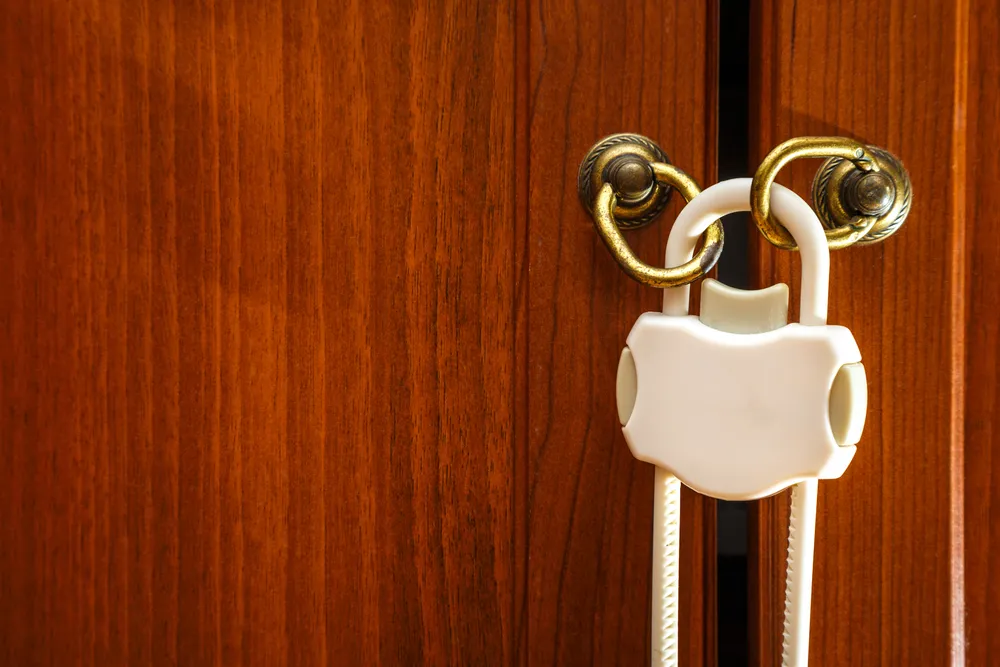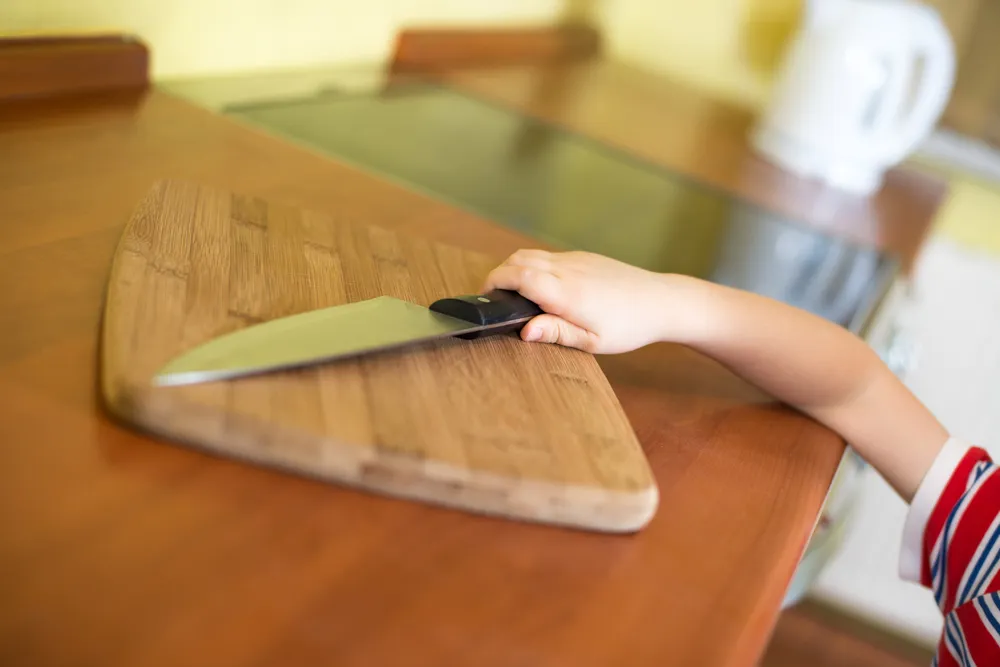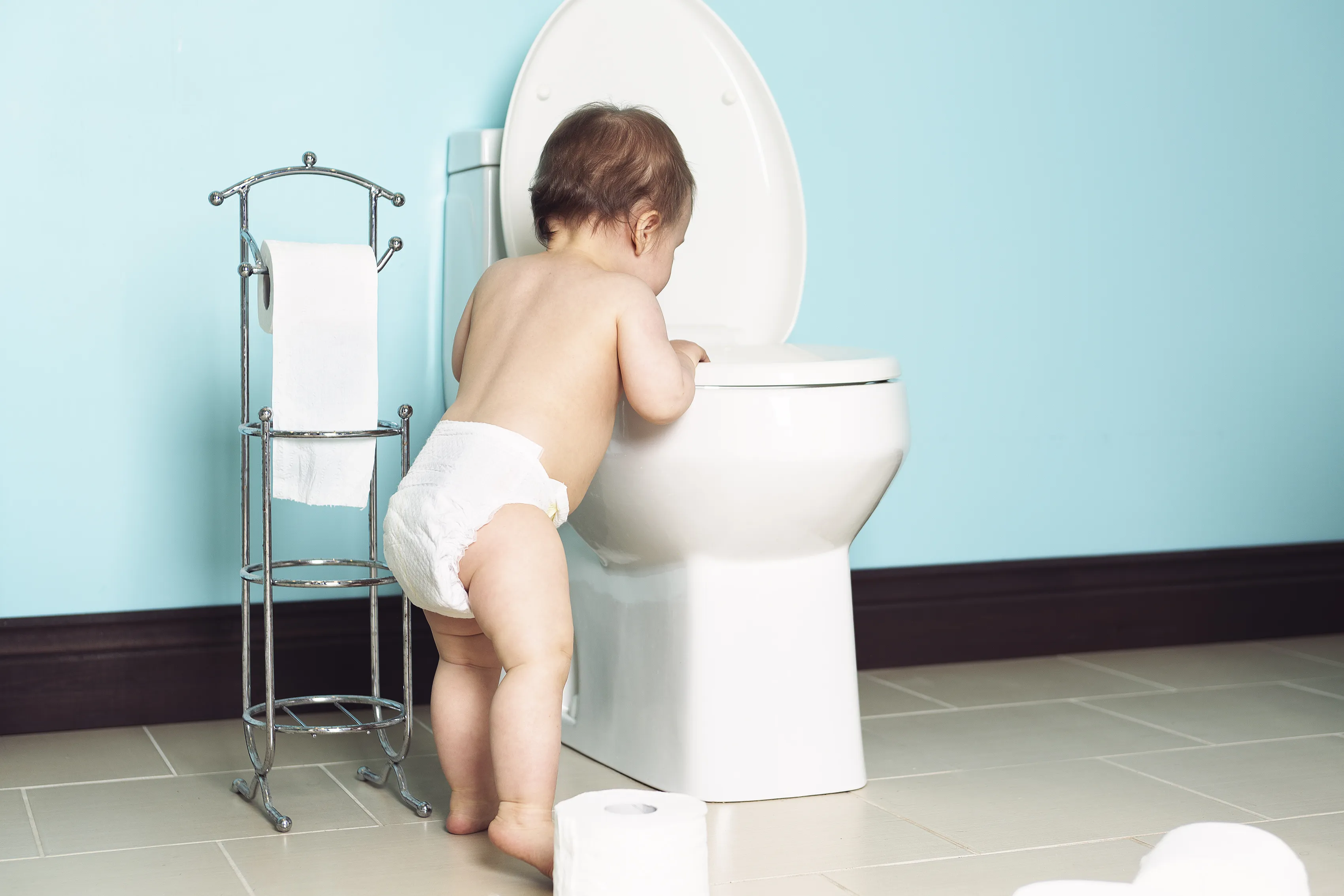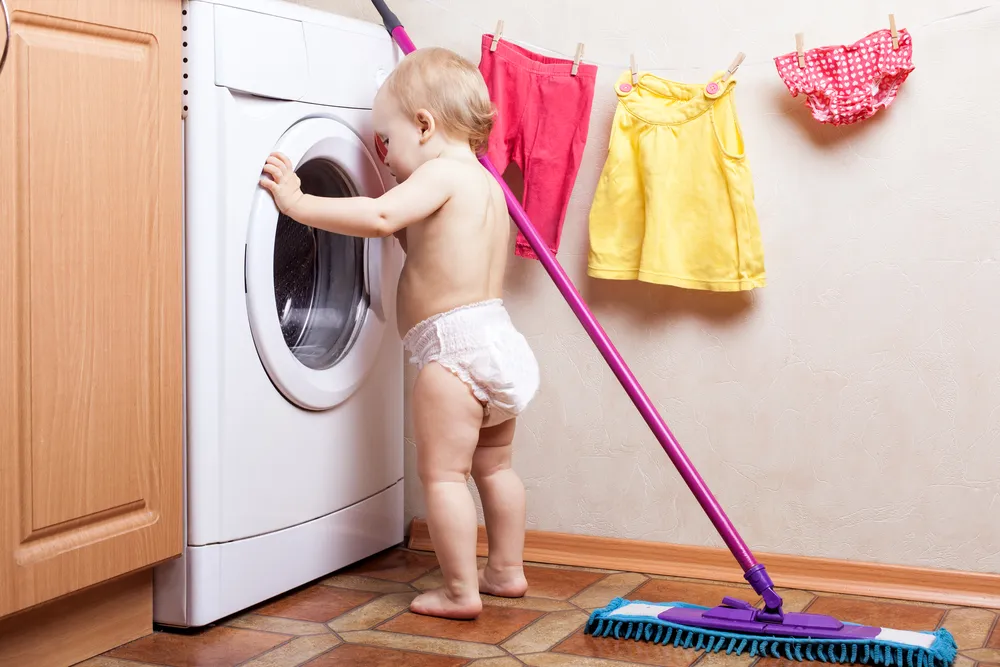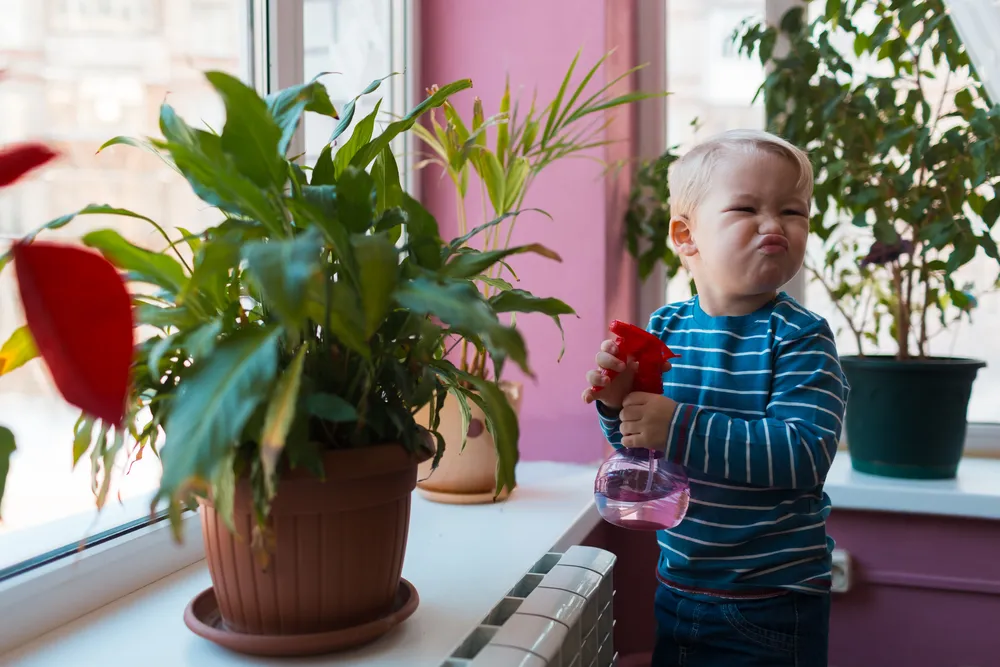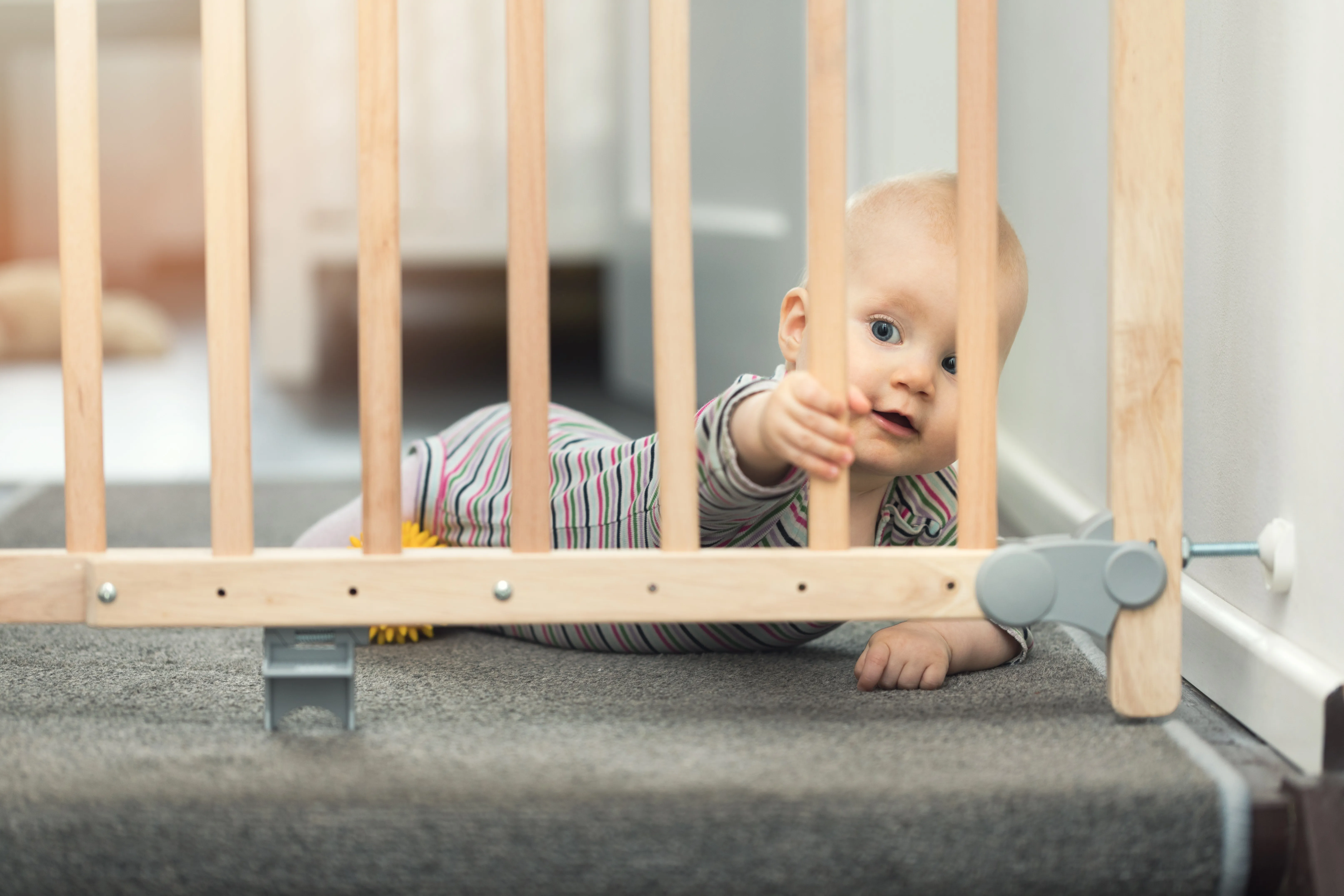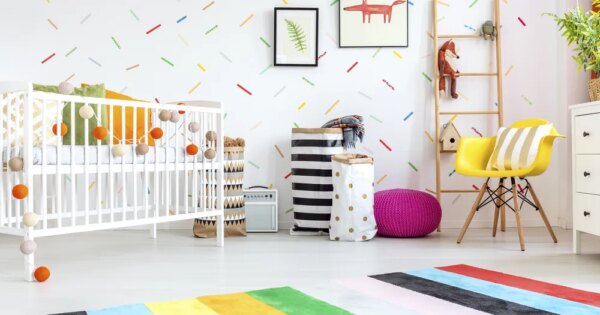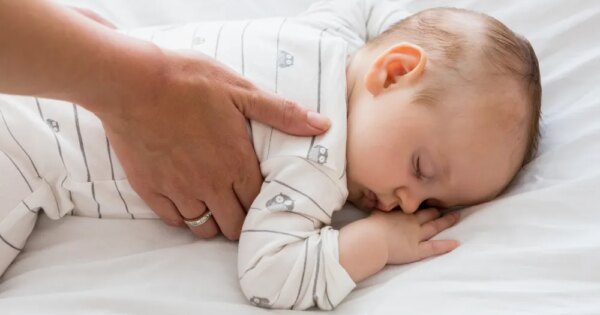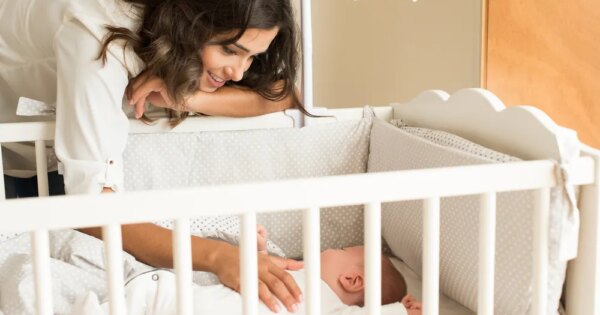We never want anything bad to happen to our children, so it is important that we take precautions to ensure their safety in our home. The large majority of accidents and injuries can be preventable by taking the time to childproof your home. Many childproofing solutions can be done relatively quickly and a very little cost. Here are some ways that you can childproof your home…
23. Secure Big Screen Televisions
As big screen televisions become more affordable, we are finding them pop up in more households. These large screen televisions can be very heavy and can pose potential dangers to young children. Recent studies show that more young children than ever are being hurt — some seriously — by falling televisions.
Top-heavy, flat-screen televisions can tumble onto children and crush their small bodies, causing brain damage or nerve damage, or in worst case scenarios, even fatally damage their skulls. The single most important safety measure parents can take in this case is to carefully secure big screen TVs to the wall or to its base so that it cannot topple over even if climbed upon or bumped into by an active child.
22. Anchor Large Furniture Pieces To The Wall
In addition to anchoring the television (and other electronic devices), it is imperative that you anchor furniture and large appliances to the walls, too. In the news I am sure you have heard of injuries and even deaths caused by furniture falling on to small children. The Consumer Product Safety Commission (CPSC), along with retailer, IKEA, have since announced a repair program that includes a wall anchoring kit for their dressers.
Tip-over incidents can happy with any kind of furniture or electronic, of course it is not IKEA-specific items only. Whether they are caused by a child climbing on the furniture, it being knocked down, or even falling in an earthquake (depending on where you live), securing large furniture pieces such as dressers, dining room hutches, bookcases, etc is so important! If your furniture doesn’t come with a wall anchoring kit, you can pick one up in store or online.
21. Secure Dangling Window Blind Cords
Dangling window blind cords can pose a serious danger to children. According to a study by the CPSC every month at least one child (aged 7-11 months) dies from strangulation after becoming entangled in a window cord. They also discovered that 60-percent of these events involved cords from horizontal blinds, 40-percent involved continuous loop systems used in both blinds and drapes, and 80-percent involved older model products.
The best way to ensure your child’s safety is to make sure all window coverings are up to date, meet current standards and are not on a recall list. Move all furniture so that dangling cords are out of reach. Continuous loop cords should be anchored to the ground or wall. You can also use tie down devices, cord stops or remove all looped cords entirely.
20. Store Cleaning Products Out of Reach
Statistics in the US indicate that at least 300 children are treated in hospital for poisoning each day. Of those, two or more will die. Children can be poisoned by accidentally (or purposefully) ingesting daily household cleaners that we all have laying around the house. Items such as bleach and other detergents are among the most common culprits. There are also hazards in the garage to consider — like anti-freeze — that its bright color may look like juice, but is most certainly not!
Children are naturally curious, busy learning and exploring about their new and exciting world. They explore with all their senses — and this includes taste and by putting things into their mouths. For this reason, it is so important that parents take active steps to prevent such poisonings. If it isn’t possible to buy natural and safe-if-accidentally-ingested products, than make sure they are kept far out of reach of curious little hands!
19. Store Medications Out of Reach
Not only do cleaning products pose threats of poisoning, children can be poisoned by the accidental ingestion of medications left lying around or not stored in a childproof container. Not to be confused with candy, children being the curious creatures they are may pop one (or a handful) of these colorful pills into their mouth, and parents may not even realized it has happen until it is too late.
Again, parents can take steps to prevent this from happening by disposing unused and expired drugs, locking up all of their medications and storing them high up and out of reach, and better yet — locking the cabinet to ensure their little hands stay far away from the potentially life-threatening hazards altogether.
18. Keep Plastic Bags Out Of Reach
Plastic grocery, garbage, dry-cleaner and even small food storage bags and wraps can be very dangerous when in the wrong hands. They can result in suffocation if your child places them over their mouth and nose, thus preventing breathing. Always store these items in a safe, child-resistant locked cupboard or drawer where they can not be easily accessible. Be very careful about not leaving any laying around.
Bags are not toys! On average, 20 children die each year from suffocation by plastic bags. Keep a close eye on your little ones and teach your child not to play with these bags or to place any object over their face that will prevent them from being able to breathe properly.
17. Use Alarms or Security Chains to Keep Kids In
Young children love to explore. It’s a natural part of growing up. They are curious about their surroundings and love to look around the corner to see what surprises await. This curiosity can, however, get them into serious trouble. Children don’t have a sense of danger to keep their inquisitiveness in check. That’s why it’s so important for adults to provide a safe and secure environment for them to explore.
Make sure that the front, back and side doors to your home are locked from the inside or use a chain up high so children cannot escape outside unsupervised. There have been incidents of children slipping out the door in the dead of winter and freezing to death, or running out onto the street and getting hit by a car. You should also make sure children cannot slip out through or fall out of open (or even screened) windows.
16. Pet Safety
Pets can be loving and valuable members of the family and require special consideration for safety when children are around. Children should always be supervised by a responsible adult when in the company of pets. Even the most gentle-natured pets could still pose a safety concern for our children. Some of the safety hazards associated with the presence of pets in the home include: bites, scratches, allergies to pet fur, falls from pets tripping or knocking a child over, and choking (children swallowing pet food or toys).
Make sure you choose a pet from a reputable breeder and is good around children. Reptiles are not recommended for children under 5 due to the potential spread of disease. Take care of your pet’s health with regular immunizations, de-worming and flea treatment. Teach your children to practice good hand washing after contact with their pet.
15. Prevent Burns
Because children learn by exploring and touching things, their curiosity can certainly get the best of them if they touch something that could burn them. Ovens and stove tops can be very dangerous, so parents should ensure that their child stay back and keep their curious hands down when it comes to these things! Hot kettles, pots and sauce pans also pose risks. Turn handles of cooking pans in towards the back of the stove, and better yet, keep them on the back burner and further from reach.
Being a parent often demands that we multitask — but one thing we should never do is carry a child and hot liquids at the same time! Something that many parents might not think of immediately as a threat is table clothes. You never know when your little Houdini is going to try to pull the table cloth out, and bring hot food and beverages crashing down. We always have to be on the look out and never leave our children (or hot items) unattended! Other dangerous items to consider blocking access to include: space heaters, hot water heaters, fireplaces, irons, and hair straighteners — to name a few. Keep items unplugged when not in use, to insure they are not accidentally turned on and cause any harm.
14. Bath and Pool Safety
Drowning is the second most common cause of death in small children under the age of 5. A child can drown in as little as 2.5 centimeters of liquid. Children should never be left alone unsupervised around water. A ratio of one adult per baby and one adult per two children is recommended. This includes baths and pools — not even for a few seconds! When it comes to pool safety a toddler should always be within arm’s reach of an adult. Water wings and floating devices are NOT safety devices that can guarantee your child’s safety! Swimming pools should be fenced on all four sides and allow not direct access from a deck. Fencing needs to be climb resistant and a minimum of 4-feet high. Gates need to be self-closing and self-latching. Unfenced hot tubs need to have a locking hard cover and/or locked in an area which can be blocked off.
Testing the temperature of the bath water is also very important when it come to your child’s safety. There are even some cute bath toys that you can purchase that also double as a thermometer! Most thermometers indicate an ideal temperature of 37 degrees celcius to 38 degrees celcius, which is around body temperature.
13. Farmhouse Safety
For those of us who dream of living the county life, and have a love for wide opens spaces and life on a farm, there are many additional hazards that can come with living on a farm that are important for families to consider. Farm accidents are widespread and can often be catastrophic. Extra diligence is required to keep children safe while on the farm. They should never be allowed near farm equipment unsupervised. This includes tractors, combines, balers, mowers, power tools and any other types of equipment found on the farm.
When children ride of farm vehicles — such as pick up trucks, they should be belted in as they would be in your regular family vehicle. The same rules should apply to keep your child safe. Although it may seem fun to let them ride in the back of the pick up truck or on the side of a fender — don’t let them! Furthermore, children should be taught to be cautious of livestock and their young as mothers may attack them if they feel threatened. They should always wear a helmet when riding a horse and should wash their hands after handling animals. Children also need to be kept away from fertilizers, chemicals, and hazardous storage areas.
12. Cupboard, Freezer, and Fridge Locks
As we have said it many times before, we know young children love to explore, touch, taste, and hide. Installing child locks on all cupboards, fridges, and freezers can help keep curious toddlers from getting into trouble.
Children are curious and inquisitive by nature, which if left unsupervised can lead to injury and even death. The very best thing we can do to ensure our child’s safety is to keep close supervision of them. For the brief moments our back might be turned, taking the time to childproofing your home can mean the difference between life and death for the healthiest of children. Cupboard door locks are an inexpensive way to keep little hands away from heavy or dangerous items that could hurt them.
11. Plug Unused Electrical Outlets
I cannot explain what it is about little children and why they seem drawn to the electrical outlets on the walls. When visiting my parents and my son b-lined it to the outlet with a little pretend key, and was ready to stick it in — I knew it was time to get some outlet plugs for at grandma and grandpa’s house too! Unused wall outlets should always be secured. Plastic inserts can be purchased, but should your child figure how to pull them out — you will need to keep a close eye that they don’t stick them in their mouth.
Consider using safety outlets that prevent foreign objects from being inserted. You can also block outlets with the creative arrangement of furniture. If you have any extension cords in use in your home, be sure to hide them behind furniture or use a hide-a-cord device. Another alternative is you can also place electrical tape over unused plug holes on cords.
10. Preventing Cuts
As parents, it is our responsibility to keep our children protected from sharp and dangerous items inside and outside our home. Keep knifes, forks, scissors, and other sharp utensils in a drawer with a safety latch. Furthermore, don’t keep these sharp items on the counter within reach. Even if your child can’t see the counter, they could still easily reach up and be seriously injured if they get a hold of something sharp. Here are some important ways that we can protect our children from sharp household object injuries:
Keep glass objects, such as drinking glasses and bowls in a high cabinet far from reach of your curious little one. Make sure that mirrors are securely attached to the wall, keep paper shredders out of reach (AND unplugged when not in use). Store appliances with sharp blades (like blenders and food processors) in a child-resistant locked cabinet. Keep you little ones back at a safe distance when you load or unload the dishwasher to prevent them from grabbing or falling onto sharp object inside the dishwasher. Keep shaving razors in a locked bathroom cabinet along with other sharp personal grooming instrument like nails scissors, etc. In garages and outdoor spaces, take extra care to store all tools, including those used for gardening, automotive and lawn care, out of reach or in locked containers or cupboards. When recycling glass items or sharp metal items, keep your recycling container locked and out of reach to prevent cuts or even possible poisoning from trace substances that may be left in the container. Even though we can’t always protect our little ones from getting cuts and scrapes on the playground, we can do everything in our power to make sure they are safe from getting cuts at our homes!
9. Fasten Toilet Lids With Child-Resistant Lock
While using the toilet is perfectly safe for adults, children are a different story. The American Academy of Pediatrics warns that the toilet is an overlooked drowning hazard for children in the home. Children are curious, often uncoordinated, and incredibly top heavy. If your child was to fall head first into the toilet, he or she could very easily become stuck and potentially down.
The easiest way to baby proof the toilet is to keep the door shut and secured at all times. A simple way that parents can do this is by installing a hook-and-eye lock up high on the door out of your child’s reach. There are also door knob safety-covers — but I have heard story’s of children figuring out how to use them. As a further precaution, a baby proof toilet latch is the next best way to keep your child safe. There are a variety of options available so find one that will work with your specific toilet.
8. Keep Little Ones Out of The Laundry Room
My son loves to help with the laundry! Helping out with easy things like moving clothes from the washer to the drying or helping fold, is a great way to introduce them to pitching in with family chores. However, there are definitely hazards to be aware of when it comes to being in the laundry room! Here are some ways that you can keep your children safe in the laundry room of your home:
Keep laundry detergent out of reach and out of sight of your child. The brightly colored stuff is very attractive to little ones and they may confuse laundry packets for candy, or liquid detergent as juice! Make sure these items are locked and completely out of reach and sight! Locking your washer and dryer doors are also important. Although it may look like a fun hiding spot for your child’s next game of hide and seek, but there is the danger of them getting stuck inside. If your machines do not have a built-in locking feature, you should consider purchasing a child safety lock for these items. If you are pre-treating any pieces of laundry, make sure that the articles being treated are out of reach of your little ones. The chemicals could get into your child’s eyes or mouth or even irritate their skin. Keeping kids out of the laundry room (unless accompanies by an adult) is the safest way to keep our little one’s safe A hook-and-eye lock kept up high (like on bathroom doors) might be also helpful to keep kiddos from wandering into the laundry room unattended.
7. Keep Little Hands Out Of Waste Baskets
Keep curious toddlers out of the grubby garbage by storing waste bins in a cabinet locked with a baby proof latch on the door. Not only will it keep them safe from any harmful items inside, but it will also keep them from throwing out something they shouldn’t — like your keys or other things that clearly don’t belong in the trash!
Don’t forget about the waste baskets in your bathroom! These should also be kept out of reach in a locked cabinet whenever possible. If this is not a possible option for you, get a garbage bin with a locking lid, that only mommy and daddy can get into, or alternatively, there are safety latches that are compatible for keeping trash can lids locked, and keep little hands out!
6. Don’t Put Photos/Frames Or Shelves Above Crib
Designing our child’s nursery can be a fun project — choosing a theme and picking cute paint colors — but it is easy to get caught up in all of the fun decor stuff, and forget about important safety concerns. Home accidents send nearly 2 million children under the age of 4 to the emergency room each year, according to Safe Kids Worldwide. Before your little one moves into their new bedroom, it is important to ensure they are in the utmost safe environment — free of hazards!
It is very important not to hang frames or shelves above your child’s crib where they can be reached and knocked down off the wall and potentially seriously injure them. Keep these items away from the crib, completely out of reach, and stick to lightweight artwork rather than mirrors, heavy picture frames, and shelves that could potentially seriously injure your child if they fell.
5. Remove Mobile Once Your Child Can Stand
Once your little one can stand, their mobile should be removed. Any decorations with long strings, ribbons, or anything else that could potentially pose a strangulation hazard, should be kept completely out of reach! Take you mobile down before your child can pull them self up (usually around 5 or 6 months) so that they can’t be tangled in the strings.
The same goes for blinds (as mentioned previously). Keep children’s cribs and beds away from windows and their blind cords. If this is unavoidable, again, ensure that the cord is fastened securely so that it cannot be reached and potentially wrapped around your child’s neck.
4. Keep Household Plants Out of Reach
Before you go to your local garden store, take some time to research what plants are or aren’t safe for your children (and even pets too). There are many household plants that are considered safe — some popular options include: African Violets, Boston Fern, Christmas Cactus, Coleus, Jade Plant, Miniature Rose, Spider Plant and Wandering Jew — to name just a few.
If you have plants that are toxic, consider a ‘plant swap’ with a friend who may have pet or child-safe plants, but do not have children or pets! There are health benefits of having houseplants, so long as you choose your plants with care, and still keep them out of reach (when possible) of curious little hands. No body wants a mud pie factory in their living room!
3. Store Alcohol, Lighters, & Matches Out of Reach
I think this one goes without saying — these items should never be within reach of small children — and teenagers too for that matter! Store alcohol in a high cabinet, locked and completely out of reach. Alcohol can be a dangerous poison for children. Alcohol depresses the central nervous system and causes low blood glucose (sugar). Children who consume alcohol can have seizures and even go into a coma, or worse — die. This is true of beer, wine, or liquor and even alcohol found in mouthwash and other personal care or household products.
Matches and lighters should also be stored high, out of reach, and in a locked drawer or cabinet. Any time a child plays with fire, the outcome could be deadly. Every year, children are killed or injured by playing with fire. A child needs only to be left alone for a few minutes to get into these items and start a fire. The National Fire Protection Agency reports that just over half of the child-playing with matches or lighters fires in the home are started in a bedroom. It is important to teach our children that they not play with matches or lighters, and should they find any, that they hand them to a responsible adult. Fire is not a toy! Additionally, when your child is old enough for more serious discussions, it is important to talk to them about the potential dangers of fire, teach them about fire safety (stop, drop, and roll), as well as what your homes fire escape plan would be should you ever need it. Parents, also remember to maintain your smoke alarms to ensure they are in good working order!
2. Avoid Choking Hazards
Choking is a leading cause of injury and death among children, especially those under 4 years of age. Kids love to explore and stick things into their mouths, which can be very dangerous as small items can very easily become stuck and lodge in their tiny airways, preventing them from being able to breathe.
The majority of choking-related incidents among children are associated with food, small toys, and coins. It is important that parents keep small items high up, securely locked, and out of reach of small children. Most importantly keep a close eye on your child in case something does get stuck in their throat! When becoming a parent, it is also not a bad idea to take a course in CPR and learn what to do should your child start to choke. It is always good to be prepared!
1. Use Safety Gates at the Top and Bottom of the Stairs
Last, but certainly not least, parents should invest in baby gates! According to the CDC, approximately 8,000 children are treated in emergency rooms across the United States for fall related injuries each day! That blows my mind! That adds up to over 2.9 million injuries every year. One of the most common places where these falls occur are on the stairs.
Fortunately for us, there is a quick and simple way to baby proof our stairways, by using baby gates. Baby gates are recommended for both at the top and bottom of stairwells. This will prevent children from falling down, or climbing the stairs and falling. For stairwells that get high traffic, you will want to invest in a gate with an easy-open handle that you can do with one hand. Many people also purchase gates to block small children from wandering in or out of certain rooms. There are tension varieties or others that can be fixed and fastened to the wall and stairwell. Consider what would work best for your family — however, at the top of the stairs, it is usually recommended you use one that is securely fastened to the wall, as the tension one could potentially be pushed through if not fastened tight and as your child gets bigger and stronger! Happy child-proofing to keep your little monkeys safe!
